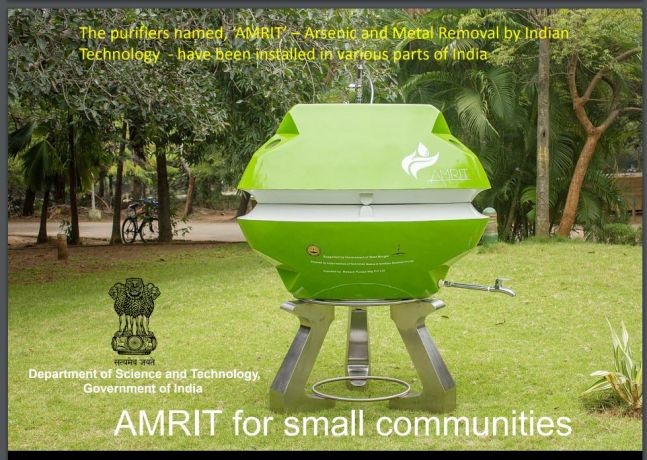Description

Disclaimer: Copyright infringement not intended.
Context
Amrit Technology for removal of arsenic and metal ions from water.
Details
Jal Jeevan Mission (JJM)
- Mission Objective:
- Initiated in August 2019 by the Government of India to ensure safe and adequate tap water supply to rural households.
- Implemented in collaboration with states, where they hold responsibilities for planning, execution, and maintenance of water supply schemes.
- Progress:
- At the outset of JJM in August 2019, only 16.8% (approximately 3.23 Crore) of rural households had tap water connections.
- Progress report as of 07.12.2023 indicates significant development, with around 10.53 Crore additional rural households provided with tap water connections.
- Currently, out of the total 19.24 Crore rural households in India, about 71.51% (approximately 13.76 Crore households) have access to tap water supply in their homes.
State Responsibility
- State Control:
- Drinking water is under state jurisdiction, allowing states to choose water technology for piped supply schemes, especially in addressing water quality issues.
- Government Support:
- The central government aids states by offering technical and financial assistance for implementing JJM.
- Collaborates with institutions like Indian Institutes of Technology (IITs) to provide guidance on suitable technologies to tackle water quality concerns.
Arsenic Removal Technology - 'AMRIT'
- Technology Development:
- Indian Institute of Technology (IIT) - Madras developed 'AMRIT' (Arsenic and Metal Removal by Indian Technology).
- Utilizes nano-scale iron oxy-hydroxide to selectively remove arsenic and metal ions from water.
- Adaptable for both domestic and community levels of water purification.
- Endorsement and Application:
- 'AMRIT' technology has received endorsement by the Department of Drinking Water and Sanitation's 'Standing Committee'.
- Recommended for assessment of water and sanitation technologies.

Water Quality Measures
- Short-Term Measures:
- Operational guidelines of JJM necessitate the provision of interim measures, like Community Water Purification Plants (CWPPs), in areas affected by water quality issues, including arsenic.
- Immediate Implementation:
- As reported on the Integrated Management Information System (IMIS) of the Department, all 378 arsenic-affected habitations lacking tap water supply have been equipped with CWPPs, ensuring safe drinking and cooking water.
About Arsenic
- Arsenic is a naturally occurring chemical element with the symbol 'As' and atomic number 33.
- It is commonly found in the Earth's crust and can be present in various forms, including inorganic and organic compounds.
- This metalloid has both metallic and non-metallic properties, making it versatile in different industrial applications.
Properties and Occurrence of Arsenic:
- Physical Properties:
- Arsenic is a gray, metallic-looking solid at room temperature and has a metallic luster.
- It can exist in various forms: yellow, black, and gray arsenic. The yellow form is the most unstable.
- Chemical Properties:
- Arsenic reacts with oxygen and water but doesn’t dissolve in non-oxidizing acids.
- It forms various compounds, both organic and inorganic, with different chemical behaviors.
- Occurrence:
- Found naturally in soil, rocks, water, air, and living organisms.
- Commonly occurs in combination with other elements like sulfur, oxygen, and metals, especially in minerals.
Uses and Applications:
- Historical and Industrial Uses:
- Historically used in various fields like medicine, agriculture, and cosmetics.
- Once widely used in manufacturing, especially in wood preservatives, pesticides, herbicides, and some metal alloys.
- Current Applications:
- Semiconductor industry: Arsenic is used in the production of semiconductors, gallium arsenide-based electronics, and solar cells.
- Pharmaceuticals: Arsenic compounds have been explored in medical treatments, particularly in some cancer treatments.
- Agriculture: Formerly used in pesticides and herbicides, but its use has been largely restricted due to its toxicity.
Health and Environmental Concerns:
- Toxicity:
- Arsenic is highly toxic and exposure to elevated levels can cause severe health issues.
- Inorganic arsenic compounds are particularly dangerous and have been associated with various health problems, including cancers (skin, lung, bladder, etc.), skin lesions, cardiovascular diseases, and developmental issues.
- Environmental Impact:
- Arsenic contamination in water sources poses a significant environmental concern.
- Groundwater contamination with arsenic is a global issue and a major public health risk in some regions.

Arsenic in Water:
- Sources of Arsenic:
- Arsenic occurs naturally in the Earth's crust and can seep into groundwater, especially in regions with specific geological formations.
- Anthropogenic sources include industrial activities like mining, smelting, and pesticide use.
- Health Risks:
- Chronic exposure to arsenic in drinking water can lead to skin lesions, cancers of the skin, bladder, and lungs.
- Long-term ingestion results in cardiovascular diseases, diabetes, and developmental issues in children.
Detection and Measurement:
- Testing Methods:
- Arsenic levels are measured using analytical methods such as atomic absorption spectroscopy (AAS) and inductively coupled plasma mass spectrometry (ICP-MS).
- Field test kits are available for on-site screening of water for arsenic contamination.
- Regulations:
- International standards set safe arsenic levels in drinking water. The World Health Organization (WHO) guideline is 10 µg/L, while different countries may have varying permissible limits.
- Regular monitoring and compliance with these standards are crucial to safeguard public health.
Mitigation Strategies:
- Treatment Technologies:
- Coagulation-Filtration: Adding chemicals to water to bind arsenic, followed by filtration to remove arsenic precipitates.
- Adsorption Methods: Using activated alumina, iron oxide, or activated carbon to absorb arsenic.
- Ion Exchange and Reverse Osmosis: Techniques to remove arsenic by exchanging ions or through selective filtration.
- Community Interventions:
- Community-level water treatment systems employing cost-effective technologies are vital for affected regions.
- Public awareness campaigns about the dangers of arsenic contamination and the importance of safe water sources.
Challenges:
- High-cost associated with advanced treatment technologies is a barrier, especially in low-resource regions.
- Ensuring sustainable access to safe water sources and regular monitoring in arsenic-affected areas remains a challenge.
- Ongoing research focuses on developing low-cost, efficient arsenic removal technologies suitable for different settings.
- Collaboration between scientific institutions, governments, and NGOs to implement effective arsenic mitigation strategies.
Toxic metals in water
Sources and Entry into Water:
- Natural Sources:
- Geological processes like weathering of rocks and soil erosion release toxic metals into water bodies.
- Minerals and ores contain these metals, leaching into groundwater or surface water.
- Anthropogenic Activities:
- Industrial discharge, mining, improper waste disposal, and agricultural runoff are primary human-made contributors to water contamination.
- Pipes, fittings, and storage tanks can leach metals, adding contaminants to drinking water systems.
Common Toxic Metals:
- Arsenic:
- Sources: Natural occurrence in rocks, human activities like mining, industrial discharge.
- Health Impacts: Causes skin lesions, cancers, cardiovascular issues, and developmental problems.
- Lead:
- Sources: Plumbing systems, lead-based paints, batteries, industrial waste.
- Health Impacts: Affects the nervous system, developmental issues in children, hypertension.
- Mercury:
- Sources: Industrial discharge, mining, combustion of fossil fuels.
- Health Impacts: Neurological issues, impaired vision, kidney problems, developmental issues in children.
- Cadmium:
- Sources: Industrial discharge, batteries, metal plating.
- Health Impacts: Kidney damage, skeletal issues, respiratory problems.
- Chromium:
- Sources: Industrial waste, tanneries, stainless steel manufacturing.
- Health Impacts: Respiratory issues, skin irritation, lung cancer.
Detection and Measurement:
- Analytical Methods: Various methods such as spectroscopy, chromatography, and atomic absorption are used to detect and measure toxic metals in water.
- Regulatory Standards: Different countries have set permissible limits for toxic metals in drinking water to safeguard public health.
Mitigation Strategies:
- Water Treatment: Techniques like coagulation-filtration, ion exchange, reverse osmosis, and adsorption used to remove toxic metals from water.
- Community Initiatives: Establishing community-level water treatment facilities to provide safe water in affected areas.
- Public Awareness: Education on the risks of consuming contaminated water and the importance of using safe water sources.

Conclusion
Toxic metals in water pose a serious threat to public health and the environment. A multifaceted approach involving stringent regulations, efficient monitoring, advanced treatment technologies, and global cooperation is essential to mitigate the risks associated with these contaminants and ensure access to safe and clean drinking water for all.
MUST READ ARTICLES:
https://www.iasgyan.in/daily-current-affairs/jal-jeevan-mission-13
|
PRACTICE QUESTION
Q. Discuss the health impacts, detection methods, and mitigation strategies concerning toxic metals in water. How can nations ensure the provision of safe drinking water while addressing the challenges posed by these contaminants? Elaborate with examples and potential solutions (250 Words)
|















